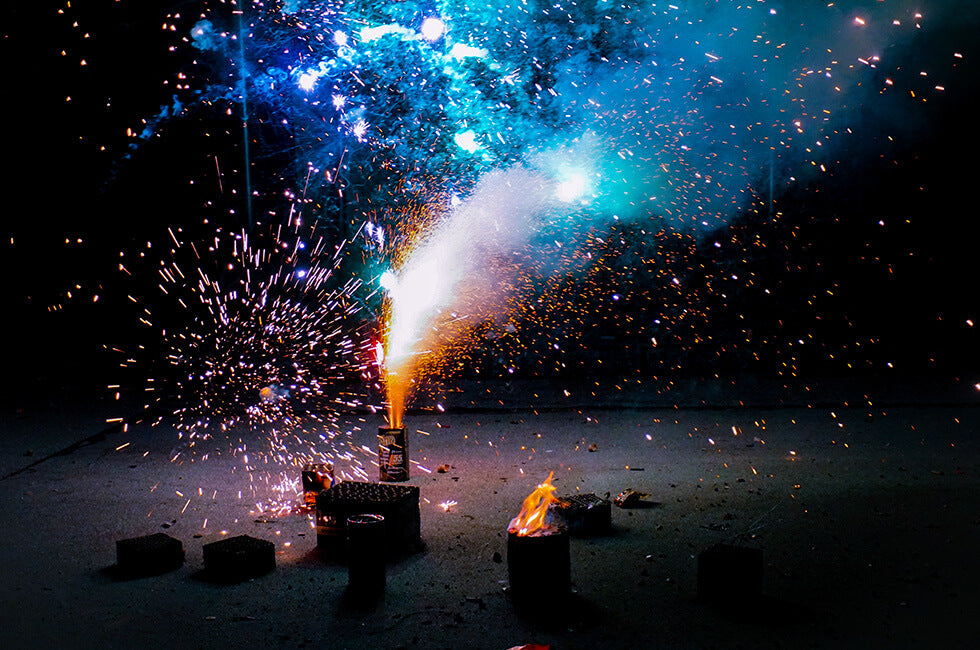All Let’s Party Fireworks are designed with firework safety rules in mind. However, to ensure firework display safety in your garden, you should take certain precautions and make sure you are well prepared.
Firework Display Safety
Preparation
You should always nominate one person to be in charge of the firework lighting. For larger displays, you should enlist the help of various individuals in advance to ensure firework safety. Make sure your firing site can accommodate the type of fireworks you want to fire as you may need more space than you think.
Read Instructions
Every firework comes with its own set of instructions due to the fact that different fireworks behave differently and need to be set up and secured in their own unique way to guarantee firework safety. In recent years, many different styles have been introduced and you should take extra care to ensure you’re setting it up correctly. Mult-shot fireworks, mines, roman candle fireworks, fountain fireworks and pyrotechnic rocket fireworks should all be buried in soft earth. Alternatively, you can attach them to wooden stakes buried in the ground. When doing this, you should make sure the stake is nearest to the audience and attach the firework with strong tape.
Angle your fireworks away from the audience no matter how they are prepared as this minimises the chance of your firework falling over and facing the crowd. For large cakes, use a couple of stakes and remember to angle your fireworks whether they are buried or staked away from the audience.
Firework Safety For Different Fireworks
- Fountains: fountains come in the shape of a cone which makes it hard to attach them to something. If you have this type of fountain, place it on a board or flat surface such as a paving slab. Placing it on grass or earth will make it unstable and increase the risk of it falling over
- Rockets: rockets should be fired from suitable tubes. If you require more, you can make your own from some plumbing pipe, but you should always ensure that the stick of the rocket can rise freely from the pipe and ensure the head of the rocket stays stable in its upwards flight. Don’t be tempted to fire a rocket with a broken stick as this will increase the danger. Rockets should always travel into the wind, so take this into account when setting up your display.
- Bonfire: if you’re having a bonfire, they should be a safe distance away from the firework, downwind. It should also be supervised at all times. You should never use inflammable such as petrol or paraffin to start the fire and never disposed of used or unused fireworks on the bonfire.
Prepare On The Night
Follow firework safety rules to ensure you and your guests are protected every step of the way. Wear your protective clothing, goggles, hard hat and gloves to protect yourself when going near fireworks. Don’t walk around with fireworks in your pockets, they should be kept in a closed, fireproof container and taken out as and when needed. By leaving them out in the open, they could meet sparks from other lit fireworks or bonfires which ignite them. You should make sure no one can wander into the firing area – especially children – by creating some kind of barrier if you deem it appropriate. It's always a good idea to designate someone as a marshal if you haven’t already to keep an eye on the audience.
There are useful items that you will need on the night of your firework display. These include:
- Torch
- Bucket of water
- Eye protection
- Gloves
- Container of soft earth to support some fireworks
- A board to support flat bottomed fireworks
- Supports for Catherine Wheels
- Launchers for rocket fireworks
- Portfires or other suitable lighters
Firework Safety FAQs
What is a safe distance from fireworks?
A safe distance for spectating is anywhere from 35-150 feet.
Can fireworks explode without being lit?
Fireworks cannot spontaneously detonate, not even in extreme heat. This is because it must always have an ignition source to be exposed to the fuse. In essence, the only way a firework can go off is if the fuse comes into direct contact with a source of ignition, such as a flame.
Can I still let my fireworks off if it’s raining?
Although rain won’t affect the performance of the firework once it’s been lit, it’s essential that you keep your fireworks dry before the ignition. If you don’t need to lay all your fireworks out beforehand, then we recommend keeping your fireworks indoors and setting them off one by one.
If you’re putting on a professional display with your fireworks and wish to lay out your fireworks beforehand, you should leave it as late as possible to do so. In this case, we recommend waterproofing your fireworks by placing them in plastic bags and removing them just before lighting. Alternatively, you can wrap each firework in cling film so that you can leave it outside whilst wrapped. Then, when it comes to firing, simply light the fuse through the film or tear a hole to expose it.

